
Hélène Dutrieu, was a Belgian cycling world champion, stunt cyclist, stunt motorcyclist, automobile racer, stunt driver, pioneer pilot, wartime ambulance driver, and director of a military hospital.

Marie Marvingt was a French athlete, mountaineer, aviator, and journalist. She won numerous prizes for her sporting achievements including those of swimming, cycling, mountain climbing, winter sports, ballooning, flying, riding, gymnastics, athletics, rifle shooting, and fencing. She was the first woman to climb many of the peaks in the French and Swiss Alps. She was a record-breaking balloonist, an aviator, and during World War I she became the first female combat pilot. She was also a qualified surgical nurse, was the first trained and certified flight nurse in the world, and worked for the establishment of air ambulance services throughout the world. In 1903 M. Château de Thierry de Beaumanoir named her the fiancée of danger, which newspapers used to describe her for the rest of her life. It is also included on the commemorative plaque on the façade of the house where she lived at 8 Place de la Carrière, Nancy.

The Royal Aero Club (RAeC) is the national co-ordinating body for air sport in the United Kingdom. It was founded in 1901 as the Aero Club of Great Britain, being granted the title of the "Royal Aero Club" in 1910.
This is a list of aviation-related events from 1910:
This is a list of aviation-related events from 1911:

Raymonde de Laroche was a French pilot, thought to be the first woman to pilot a plane. She became the world's first licensed female pilot on 8 March 1910.
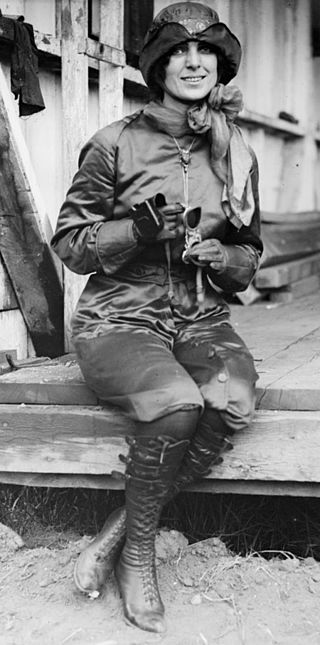
Harriet Quimby was an American pioneering aviator, journalist, and film screenwriter. In 1911, she became the first woman in the United States to receive a pilot's license and in 1912 the first woman to fly across the English Channel. Although Quimby died at the age of 37 in a flying accident, she strongly influenced the role of women in aviation.

Sabiha Gökçen was a Turkish aviator. During her flight career, she flew around 8,000 hours and participated in 32 different military operations. She was the world's first female fighter pilot, aged 23. As an orphan, she was one of the nine children adopted by Mustafa Kemal Atatürk.
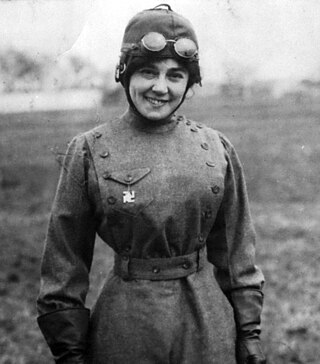
Matilde Josephine Moisant was an American pioneer aviator, the second woman in the United States to obtain a pilot's license.

The Aero Club of America was a social club formed in 1905 by Charles Jasper Glidden and Augustus Post, among others, to promote aviation in America. It was the parent organization of numerous state chapters, the first being the Aero Club of New England. It thrived until 1923, when it transformed into the National Aeronautic Association, which still exists today. It issued the first pilot's licenses in the United States, and successful completion of its licensing process was required by the United States Army for its pilots until 1914. It sponsored numerous air shows and contests. Cortlandt Field Bishop was president in 1910. Starting in 1911, new president Robert J. Collier began presenting the Collier Trophy.

Calbraith Perry Rodgers was an American aviation pioneer. He made the first transcontinental airplane flight across the U.S. from September 17, 1911, to November 5, 1911, with dozens of stops, both intentional and accidental. The feat made him a national celebrity, but he was killed in a crash a few months later at an exhibition in California.

Women Of Aviation Worldwide Week {WOAW} is a global aviation awareness week for girls of all ages observed to mark the anniversary of the world’s first female pilot licence. The week is a call to address gender imbalance in the air and space industry. It is not country or group specific
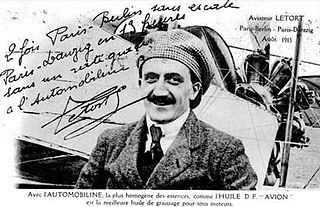
Léon Letort, was a pioneer French aviator. He gained his pilot's license on 9 August 1910, flew his Blériot in exhibitions across France, and flew on military service in the Balkan Wars. In 1913 he set the world record for the greatest distance travelled non-stop, flying 950 kilometres (590 mi) in 8 hours. He died during an attempt to win a prize for long-distance flight when he crash-landed at Barbezieux-Saint-Hilaire outside Bordeaux.
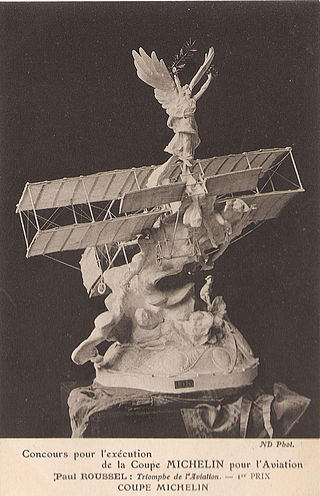
The Michelin Cup refers to a number of competitions sponsored by the French tyre manufacturer Michelin for long distance flight made in aeroplanes.

Women have been involved in aviation from the beginnings of both lighter-than air travel and as airplanes, helicopters and space travel were developed. Women pilots were also formerly called "aviatrices". Women have been flying powered aircraft since 1908; prior to 1970, however, most were restricted to working privately or in support roles in the aviation industry. Aviation also allowed women to "travel alone on unprecedented journeys". Women who have been successful in various aviation fields have served as mentors to younger women, helping them along in their careers.

This is a timeline of women in aviation which describes many of the firsts and achievements of women as pilots and other roles in aviation. Women who are part of this list have piloted vehicles, including hot-air balloons, gliders, airplanes, dirigibles and helicopters. Some women have been instrumental in support roles. Others have made a name for themselves as parachutists and other forms of flight-related activities. This list encompasses women's achievements from around the globe.
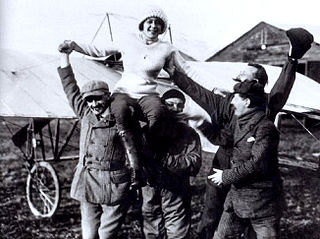
Jeanne Aline Herveux, generally known as Jane Herveu, (1885–1955) was a pioneering French aviator who obtained her pilot's licence on 7 December 1910.

Jeanne Pallier, was a pioneering French aviator before the First World War, qualifiying for her pilot's licence in 1912. Founder of le Club Féminine Automobile to provide female drivers for the ambulances near the Front in the First World War.















